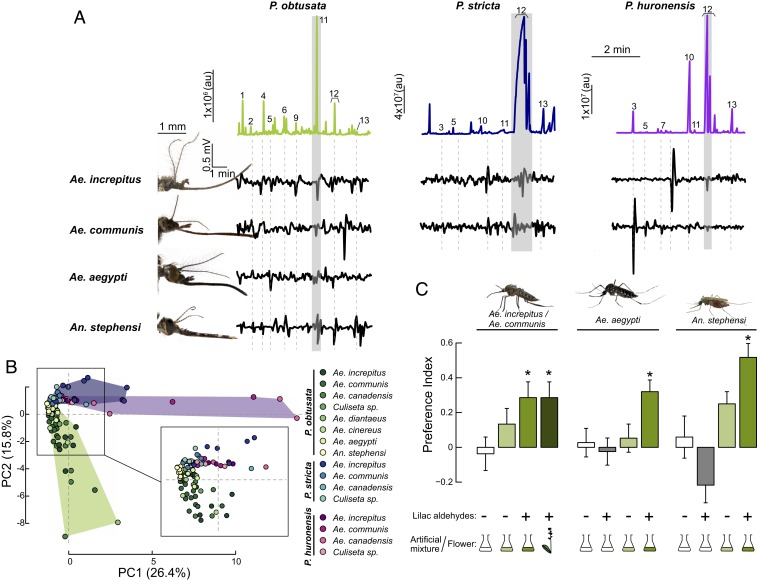Fig. 2.
Identification of behaviorally effective orchid volatiles in mosquitoes. (A) Gas chromatogram traces for the P. obtusata (Left), P. stricta (Middle), and P. huronensis (Right) headspaces, with electroantennogram responses to the GC peaks for 4 mosquito species (Ae. communis, Ae. increpitus, Ae. aegypti, and An. stephensi) immediately below. See chromatogram number correspondence in Fig. 1 legend. Mosquito images courtesy of A. Jewiss-Gaines (photographer) and F. Hunter (Brock University, St. Catharines, Canada). (B) PCA plot based on the antennal responses of individual mosquitoes from the different Aedes species to the peaks from the P. obtusata, P. stricta, and P. huronensis scents. Each dot corresponds to the responses of an individual mosquito; shaded areas and dots are color coded according to mosquito species and flower scent (green, P. obtusata; blue, P. stricta; and purple, P. huronensis). Antennal responses to the 3 tested orchid scents were significantly different from one another (ANOSIM, R = 0.137, P < 0.01) (n = 3 to 16 mosquitoes per species per floral extract). (C) Behavioral preferences by snow mosquitoes (Ae. communis and Ae. increpitus), Ae. aegypti, and An. stephensi mosquitoes to the P. obtusata scent and scent mixture, with and without the lilac aldehyde (at the concentration found in the P. obtusata headspace). A y-maze olfactometer was used for the behavioral experiments in which mosquitoes are released and have to fly upwind and choose between 2 arms carrying the tested compound/mixture or no odorant (control). A preference index (PI) was calculated based on these responses (see SI Appendix, Supplementary Methods for details). The colored flask denotes the use of an artificial mixture (dark green is with lilac aldehyde; light green is without); empty flask denotes the negative (solvent) control. The plant motif is the positive control (orchid flowers), and the + and − symbols represent the presence or absence of the lilac aldehyde in the stimulus, respectively. Bars are the mean ± SEM (n = 17 to 53 mosquitoes/treatment); asterisks denote a significant difference between treatments and the mineral oil (no odor) control (binomial test: P < 0.05). au, arbitrary units.

